
|
Pristanic acid |
Pristanic acid is a lipid of Prenol Lipids (PR) class. Pristanic acid is associated with abnormalities such as Refsum Disease, Peroxisomal Disorders, Hereditary Diseases, Peripheral Neuropathy and Sensory neuropathy. The involved functions are known as physiological aspects, Regulation, Pathogenesis, Oxidation and Peroxisome Proliferator-activated Receptor Activity [MoA]. Pristanic acid often locates in peroxisome, Body tissue, Mitochondria, Membrane of peroxisome and Organelles. The associated genes with Pristanic acid are PSG5 gene, LGALS4 gene, PEX2 gene, ACSL4 gene and ACSL1 Gene. The related lipids are pristanic acid, Fatty Acids, branched chain fatty acid, Plasmalogens and 3-hydroxypristanic acid. |
246 |
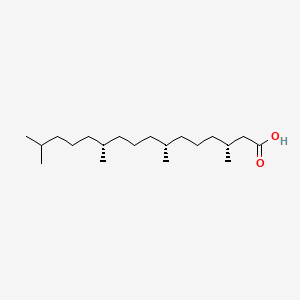
|
3d,7d,11d-phytanic acid |
|
107 |

|
Crocetin |
Crocetin is a lipid of Prenol Lipids (PR) class. Crocetin is associated with abnormalities such as abnormal fragmented structure, Gout, Infection and athymia. The involved functions are known as Cytokinesis, Anabolism, enzyme mechanism, Pathological accumulation of air in tissues and Hemorrhage. Crocetin often locates in Vacuole, Cytoplasmic matrix, Body tissue, Mitochondria and Blood. The associated genes with Crocetin are cytochrome c'', BCL2 gene and PCNA gene. The related lipids are mycorradicin. |
350 |
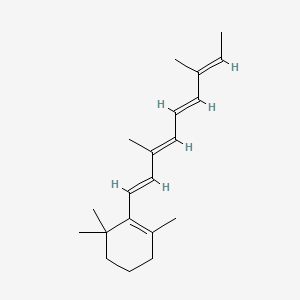
|
Axerophthene |
Axerophthene is a lipid of Prenol Lipids (PR) class. |
13 |

|
forskolin |
Forskolin is a lipid of Prenol Lipids (PR) class. Forskolin is associated with abnormalities such as Cholestasis, Vocal cord dysfunction familial, Hypothyroidism, Renal tubular disorder and Disintegration (morphologic abnormality). The involved functions are known as Cell Proliferation, Anabolism, mRNA Expression, Agent and Signal. Forskolin often locates in Extracellular, Body tissue, Skin, Tissue membrane and Membrane. The associated genes with forskolin are P4HTM gene, SLC33A1 gene, NR1I2 gene, Genes, Reporter and CYP3A gene. The related lipids are Steroids, steroid sulfate, Fatty Acids, LYSO-PC and Lipopolysaccharides. |
24755 |

|
Gibberellin A3 |
Gibberellin a3 is a lipid of Prenol Lipids (PR) class. The involved functions are known as Germination, ethylene biosynthetic process and cyclin catabolic process. The associated genes with Gibberellin A3 are IPP gene and ARF6 gene. The related lipids are brassinolide. |
1728 |

|
phorbol 13-acetate 12-myristate |
Phorbol 13-acetate 12-myristate is a lipid of Prenol Lipids (PR) class. The involved functions are known as DNA Fragmentation, Phosphorylation and Irritation. Phorbol 13-acetate 12-myristate often locates in low-density lipoprotein particle. The associated genes with phorbol 13-acetate 12-myristate are FPR1 gene and ABCB1 gene. |
40921 |
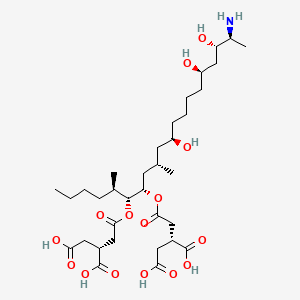
|
fumonisin b1 |
fumonisin b1 is a lipid of Sphingolipids (SP) class. Fumonisin b1 is associated with abnormalities such as Infection, Kidney Diseases, Liver diseases, DERMATITIS HERPETIFORMIS, FAMILIAL and Malnutrition. The involved functions are known as Gene Expression, Anabolism, Signal, Biosynthetic Pathways and Regulation. Fumonisin b1 often locates in Body tissue, Microsomes, microsomal membrane, Protoplasm and Mitochondria. The associated genes with fumonisin b1 are Genome, P4HTM gene, FATE1 gene, BCL2 gene and TMEM132D gene. The related lipids are dihydroceramide, ceramide 1-phosphate, Sphingolipids, Fatty Acids and Palmitates. |
902 |
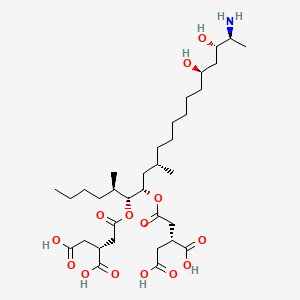
|
fumonisin b2 |
fumonisin b2 is a lipid of Sphingolipids (SP) class. |
64 |
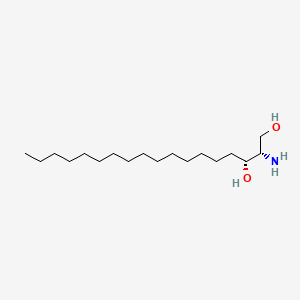
|
Sphinganine |
Sphinganine is a lipid of Sphingolipids (SP) class. Sphinganine is associated with abnormalities such as Sphingolipidoses, CLEFT LIP, CONGENITAL HEALED, Aortic aneurysm, familial thoracic 4, Morphologically altered structure and Atherosclerosis. The involved functions are known as Transcription, Genetic, Signal, Muscle Contraction, biological adaptation to stress and Gene Expression. Sphinganine often locates in Tissue membrane, Membrane, Protoplasm, Plasma membrane and Cytoplasmic. The associated genes with Sphinganine are SLC33A1 gene, HM13 gene, P4HTM gene, SPHK1 gene and SPHK2 gene. The related lipids are Sphingolipids, Phosphatidylserines, Sterols, Fatty Acids and inositolphosphorylceramide. The related experimental models are Mouse Model and Knock-out. |
758 |

|
cholesterol |
cholesterol is a lipid of Sterol Lipids (ST) class. Cholesterol is associated with abnormalities such as Trypanosomiasis, Chagas Disease, Cleft Palate, Chondrodysplasia punctata 2, X-linked dominant and Child syndrome. The involved functions are known as Blood Circulation, Sterol Biosynthesis Pathway, Receptor Mediated Endocytosis, Methylation and Signal. Cholesterol often locates in Animal tissue, Blood, Membrane, Plasma membrane and peroxisome. The associated genes with cholesterol are MBD2 gene, SIM, SLC33A1 gene, Genome and NSDHL gene. The related lipids are Sterols, zymosterol, fecosterol, Total cholesterol and 7-dehydrocholesterol. The related experimental models are Mouse Model, Knock-out, Genetically Engineered Mouse and Disease model. |
98461 |
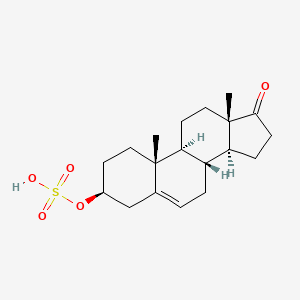
|
Prasterone sulfate |
Prasterone sulfate is a lipid of Sterol Lipids (ST) class. Prasterone sulfate is associated with abnormalities such as Cardiovascular Diseases, HIV Infections, Tuberculosis, Acquired Immunodeficiency Syndrome and Infection. The involved functions are known as Crossbreeding, Analyte, Process, Adjudication and Protective Agents. Prasterone sulfate often locates in Back, Blood, Adipose tissue, Body tissue and Immune system. The associated genes with Prasterone sulfate are FASTK Gene, SHBG gene, Serum Albumin, Alleles and prolyl-proline. The related lipids are Steroids, Total cholesterol, steroid sulfate, estradiol 17-sulfate and 16-hydroxydehydroepiandrosterone sulfate. The related experimental models are Knock-out. |
1147 |

|
Methandrostenolone |
Methandrostenolone is a lipid of Sterol Lipids (ST) class. The involved functions are known as Puberty and antagonists. |
579 |
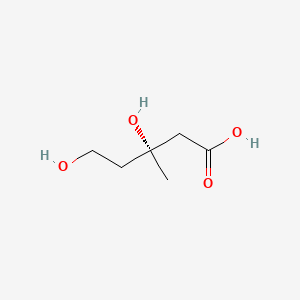
|
Mevalonic acid |
Mevalonic acid is a lipid of Fatty Acyls (FA) class. |
1437 |

|
Diosgenin |
Diosgenin is a lipid of Sterol Lipids (ST) class. Diosgenin is associated with abnormalities such as Diabetes, PARAGANGLIOMAS 3, Osteoporosis, estrogen deficiency and Bone Diseases. The involved functions are known as Process, inhibitors, Metabolic Inhibition, Diastasis and Inflammation. Diosgenin often locates in Hepatic, Extracellular, Body tissue, Entire bony skeleton and Cytoplasmic matrix. The associated genes with Diosgenin are SLC2A1 gene, Operator gene, CFB gene, IMPACT gene and iberiotoxin. The related lipids are Saponins, Saponin, Steroids, Sapogenins and yamogenin. |
557 |
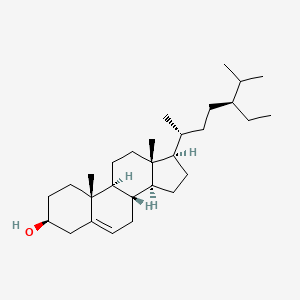
|
Clionasterol |
Clionasterol is a lipid of Sterol Lipids (ST) class. The involved functions are known as Intestinal Absorption. The related lipids are 22-hydroxycholesterol. |
711 |
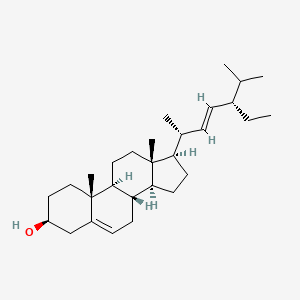
|
Stigmasterol |
Stigmasterol is a lipid of Sterol Lipids (ST) class. Stigmasterol is associated with abnormalities such as Cholestasis, Intestinal Diseases, Migraine Disorders, Vitelliform dystrophy and Mycoses. The involved functions are known as Regulation, Signal Transduction, physiological aspects, Transcription, Genetic and Bile secretion. Stigmasterol often locates in Membrane, Tissue membrane, Hepatic, Liver - Hepatocyte (MMHCC) and Cell membrane. The associated genes with Stigmasterol are ABCB11 gene, ABCC2 gene, ABCG5 gene, ABCG8 gene and SLC33A1 gene. The related lipids are Sterols, Lipopolysaccharides, campesterol, amyrin and DOPE. The related experimental models are Mouse Model. |
307 |
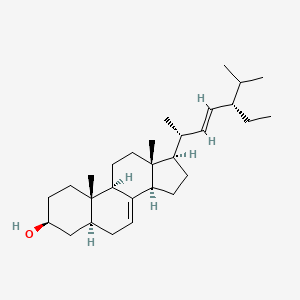
|
Spinasterol |
Spinasterol is a lipid of Sterol Lipids (ST) class. |
10 |
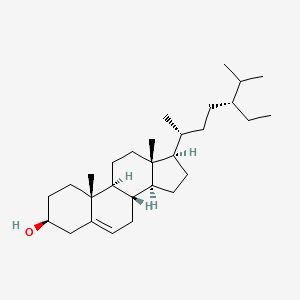
|
Beta-sitosterol |
Beta-sitosterol is a lipid of Sterol Lipids (ST) class. Beta-sitosterol is associated with abnormalities such as Obesity, Diabetes, Cholestasis, Systemic disease and Diabetes Mellitus. The involved functions are known as Increased Cholesterol Synthesis, Synthesis, cholesterol metabolism, GLUCOSE TOLERANCE and cholesterol absorption. Beta-sitosterol often locates in Blood, Back, Cell membrane, soluble fraction and Body tissue. The related lipids are Sterols, lathosterol, Total cholesterol, campesterol and Cholestanes. |
380 |
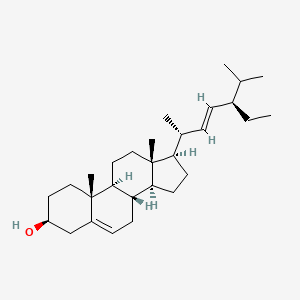
|
Poriferasterol |
Poriferasterol is a lipid of Sterol Lipids (ST) class. Poriferasterol is associated with abnormalities such as Systemic disease, Diabetes Mellitus and Mycoses. The involved functions are known as Drug Interactions, Gravitropism, Signal Transduction, unidimensional cell growth and Membrane Fusion. Poriferasterol often locates in Membrane, Cell membrane, Tissue membrane, Back and Chloroplasts. The associated genes with Poriferasterol are ETV3 gene and TERF1 gene. The related lipids are DOPE, Sterols, 24-epibrassinolide, brassinolide and Total cholesterol. |
98 |
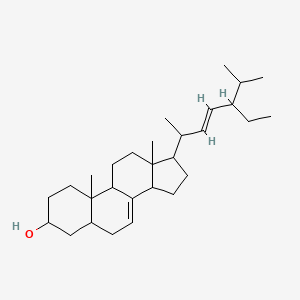
|
Alpha-spinasterol |
|
8 |
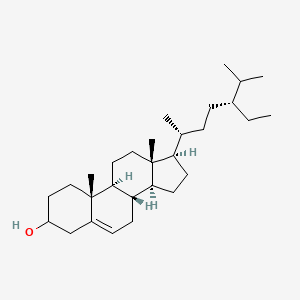
|
3beta-sitosterol |
|
234 |
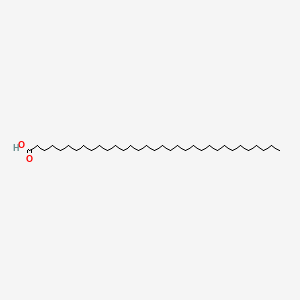
|
tritriacontanoic acid |
tritriacontanoic acid is a lipid of Fatty Acyls (FA) class. Tritriacontanoic acid is associated with abnormalities such as hypercholesterolemia, Metabolic syndrome, Diabetes Mellitus, Non-Insulin-Dependent, Diabetes Mellitus, Insulin-Dependent and Parkinson Disease. The involved functions are known as Fermentation, Process, Longterm Effects, Pressure- physical agent and Lipid Metabolism. Tritriacontanoic acid often locates in Blood, Tissue fiber and A Fibers. The associated genes with tritriacontanoic acid are STN gene. The related lipids are Total cholesterol and blood lipid. |
501 |
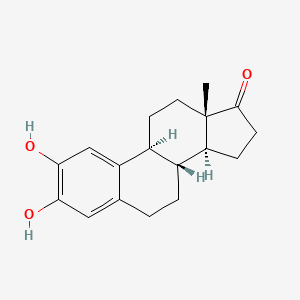
|
2-Hydroxyestrone |
2-hydroxyestrone is a lipid of Sterol Lipids (ST) class. 2-hydroxyestrone is associated with abnormalities such as Consumption-archaic term for TB and Estrogenic effect. The involved functions are known as Excretory function, Estrogen Metabolic Process, Urinary concentration, Biochemical Pathway and Cell Proliferation. 2-hydroxyestrone often locates in Mammary Gland Parenchyma. The associated genes with 2-Hydroxyestrone are CYP17A1 gene, CYP1A2 gene, SHBG gene and Alleles. The related lipids are 16-ketoestradiol and 4-methoxyestradiol. |
145 |
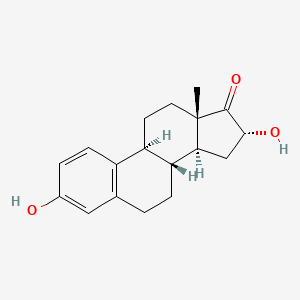
|
16alpha-hydroxyestrone |
16alpha-hydroxyestrone is a lipid of Sterol Lipids (ST) class. 16alpha-hydroxyestrone is associated with abnormalities such as Estrogenic effect. The involved functions are known as Cell Proliferation, Estrogen Metabolism, Polymorphism, Genetic and Protective Agents. The associated genes with 16alpha-hydroxyestrone are SHBG gene, Alleles and CYP17A1 gene. The related lipids are 16-ketoestradiol and 4-methoxyestradiol. |
86 |

|
Taurocholic acid |
Taurocholic acid is a lipid of Sterol Lipids (ST) class. Taurocholic acid is associated with abnormalities such as Cholestasis, Cholestatic liver disease, Exanthema, Hepatitis and Fibrosis, Liver. The involved functions are known as Uptake, Metabolic Inhibition, Drug Interactions, inhibitors and Excretory function. Taurocholic acid often locates in Hepatic, Plasma membrane, Blood, Membrane and Endothelium. The associated genes with Taurocholic acid are SLC10A1 gene, SLCO1B1 gene, SLC10A2 gene, P4HTM gene and Polypeptides. The related lipids are Steroids, Sterols, Lipopolysaccharides, 7-dehydrocholesterol and cholanic acid. |
3446 |
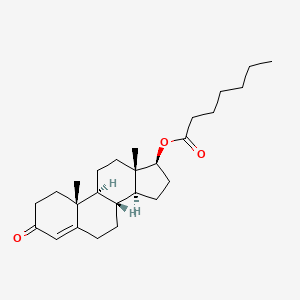
|
Testosterone enanthate |
Testosterone enanthate is a lipid of Sterol Lipids (ST) class. |
138 |

|
Norgestrel |
Norgestrel is a lipid of Sterol Lipids (ST) class. Norgestrel is associated with abnormalities such as Acne, Deep Vein Thrombosis, Thromboembolism, Activated Protein C Resistance and Hydrometra. The involved functions are known as Thrombosis, Aquatic environment, Venous Thrombosis, Thrombus and Inspiration function. Norgestrel often locates in Glial. The associated genes with Norgestrel are Genes, Reporter. The related lipids are Estranes. |
3031 |
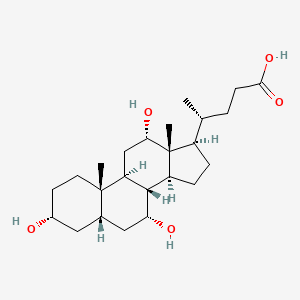
|
Cholic acid |
Cholic acid is a lipid of Sterol Lipids (ST) class. Cholic acid is associated with abnormalities such as Cholestasis, Intrahepatic Cholestasis, Atherosclerosis, Diabetes and cholesterol gallstones. The involved functions are known as Homeostasis, Enterohepatic Circulation, Proliferation (morphologic abnormality), Process and Cell Proliferation. Cholic acid often locates in Hepatic, Cytoplasmic matrix, Membrane, Protoplasm and Tissue membrane. The associated genes with Cholic acid are CYP27A1 gene, ABCB11 gene, NR5A2 gene, SLC10A2 gene and SLC10A1 gene. The related lipids are ursocholic acid, Steroids, Cholestenes, Cholestanes and cholanic acid. |
3054 |
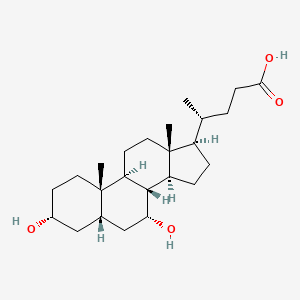
|
Chenodeoxycholic Acid |
Chenodeoxycholic acid is a lipid of Sterol Lipids (ST) class. Chenodeoxycholic acid is associated with abnormalities such as Diabetes, Fibrosis, Liver, Liver Cirrhosis, Fatty Liver and Cholestasis. The involved functions are known as protein expression, Cell Survival, Adjudication, Metabolic Inhibition and Anabolism. Chenodeoxycholic acid often locates in Hepatic, Body tissue, Tissue membrane, Cytoplasmic matrix and Mitochondria. The associated genes with Chenodeoxycholic Acid are NR1H4 gene, Candidate Disease Gene, NR0B2 gene, MYC gene and SLC10A2 gene. The related lipids are Promega, 6-ethylchenodeoxycholic acid, 27-hydroxycholesterol, Cholestenes and Hydroxycholesterols. |
2223 |
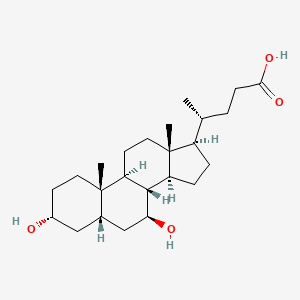
|
Ursodeoxycholic acid |
Ursodeoxycholic acid is a lipid of Sterol Lipids (ST) class. Ursodeoxycholic acid is associated with abnormalities such as Liver diseases, Cirrhosis, Hypertension, Portal, Cholestatic liver disease and Cholangitis, Sclerosing. The involved functions are known as protein expression, Fibrosis, Apoptosis, Metabolic Inhibition and Signal Transduction. Ursodeoxycholic acid often locates in Membrane, Clone, Tissue membrane, Protoplasm and Hepatic. The associated genes with Ursodeoxycholic acid are ABCC2 gene, ABCB4 gene, IMPACT gene, Alleles and PTGS2 wt Allele. The related lipids are Micelles, Steroids, cholanic acid, glycoursodeoxycholic acid and taurolithocholic acid 3-sulfate. The related experimental models are Disease model. |
3362 |
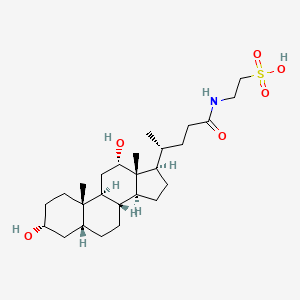
|
Taurodeoxycholic acid |
Taurodeoxycholic acid is a lipid of Sterol Lipids (ST) class. Taurodeoxycholic acid is associated with abnormalities such as Ischemia and Wiskott-Aldrich Syndrome. The involved functions are known as Cell Proliferation, Transcriptional Activation, Phosphorylation, Anabolism and Biochemical Pathway. Taurodeoxycholic acid often locates in Body tissue, Epithelium, Blood, Mucous Membrane and Hepatic. The associated genes with Taurodeoxycholic acid are NOX5 gene, GPBAR1 gene, NR1H4 gene and SLC33A1 gene. The related lipids are cholanic acid, taurolithocholic acid 3-sulfate, Sterols, 7-dehydrocholesterol and tauromuricholic acid. |
352 |
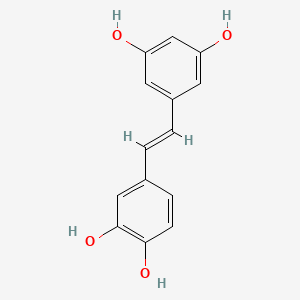
|
piceatannol |
piceatannol is a lipid of Polyketides (PK) class. Piceatannol is associated with abnormalities such as Infection, Pneumonia, BOSLEY-SALIH-ALORAINY SYNDROME, Morphologically altered structure and Renal tubular disorder. The involved functions are known as Stimulus, Inflammatory Response, Host defense, Phagocytosis and Uptake. Piceatannol often locates in soluble, Protoplasm, Back, Body tissue and Tissue membrane. The associated genes with piceatannol are Human gene, SELPLG gene, ICAM1 gene, CD1D gene and LAMP1 gene. The related lipids are Promega, Fatty Acids, Butanols, Phosphatidic Acid and phosphatidylethanol. The related experimental models are Mouse Model. |
689 |
































